Jeongeun Park
Token Bottleneck: One Token to Remember Dynamics
Jul 09, 2025Abstract:Deriving compact and temporally aware visual representations from dynamic scenes is essential for successful execution of sequential scene understanding tasks such as visual tracking and robotic manipulation. In this paper, we introduce Token Bottleneck (ToBo), a simple yet intuitive self-supervised learning pipeline that squeezes a scene into a bottleneck token and predicts the subsequent scene using minimal patches as hints. The ToBo pipeline facilitates the learning of sequential scene representations by conservatively encoding the reference scene into a compact bottleneck token during the squeeze step. In the expansion step, we guide the model to capture temporal dynamics by predicting the target scene using the bottleneck token along with few target patches as hints. This design encourages the vision backbone to embed temporal dependencies, thereby enabling understanding of dynamic transitions across scenes. Extensive experiments in diverse sequential tasks, including video label propagation and robot manipulation in simulated environments demonstrate the superiority of ToBo over baselines. Moreover, deploying our pre-trained model on physical robots confirms its robustness and effectiveness in real-world environments. We further validate the scalability of ToBo across different model scales.
Versatile Motion Langauge Models for Multi-Turn Interactive Agents
Oct 08, 2024Abstract:Recent advancements in large language models (LLMs) have greatly enhanced their ability to generate natural and contextually relevant text, making AI interactions more human-like. However, generating and understanding interactive human-like motion, where two individuals engage in coordinated movements, remains a challenge due to the complexity of modeling these coordinated interactions. Furthermore, a versatile model is required to handle diverse interactive scenarios, such as chat systems that follow user instructions or adapt to their assigned role while adjusting interaction dynamics. To tackle this problem, we introduce VIM, short for the Versatile Interactive Motion language model, which integrates both language and motion modalities to effectively understand, generate, and control interactive motions in multi-turn conversational contexts. To address the scarcity of multi-turn interactive motion data, we introduce a synthetic dataset, INERT-MT2, where we utilize pre-trained models to create diverse instructional datasets with interactive motion. Our approach first trains a motion tokenizer that encodes interactive motions into residual discrete tokens. In the pretraining stage, the model learns to align motion and text representations with these discrete tokens. During the instruction fine-tuning stage, VIM adapts to multi-turn conversations using the INTER-MT2 dataset. We evaluate the versatility of our method across motion-related tasks, motion to text, text to motion, reaction generation, motion editing, and reasoning about motion sequences. The results highlight the versatility and effectiveness of proposed method in handling complex interactive motion synthesis.
Towards Embedding Dynamic Personas in Interactive Robots: Masquerading Animated Social Kinematics (MASK)
Mar 15, 2024



Abstract:This paper presents the design and development of an innovative interactive robotic system to enhance audience engagement using character-like personas. Built upon the foundations of persona-driven dialog agents, this work extends the agent application to the physical realm, employing robots to provide a more immersive and interactive experience. The proposed system, named the Masquerading Animated Social Kinematics (MASK), leverages an anthropomorphic robot which interacts with guests using non-verbal interactions, including facial expressions and gestures. A behavior generation system based upon a finite-state machine structure effectively conditions robotic behavior to convey distinct personas. The MASK framework integrates a perception engine, a behavior selection engine, and a comprehensive action library to enable real-time, dynamic interactions with minimal human intervention in behavior design. Throughout the user subject studies, we examined whether the users could recognize the intended character in film-character-based persona conditions. We conclude by discussing the role of personas in interactive agents and the factors to consider for creating an engaging user experience.
SPOTS: Stable Placement of Objects with Reasoning in Semi-Autonomous Teleoperation Systems
Sep 25, 2023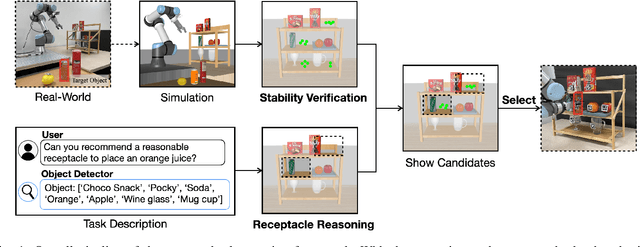
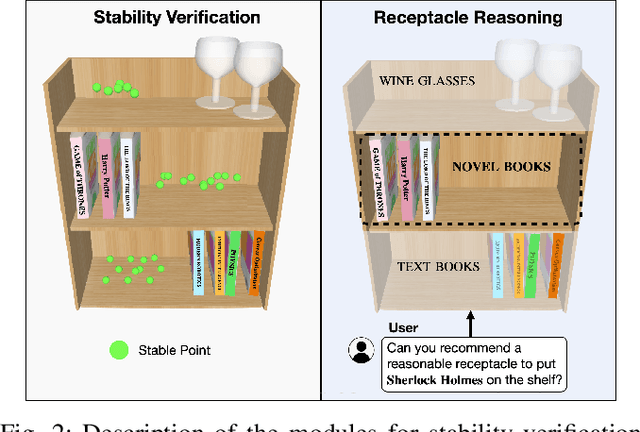
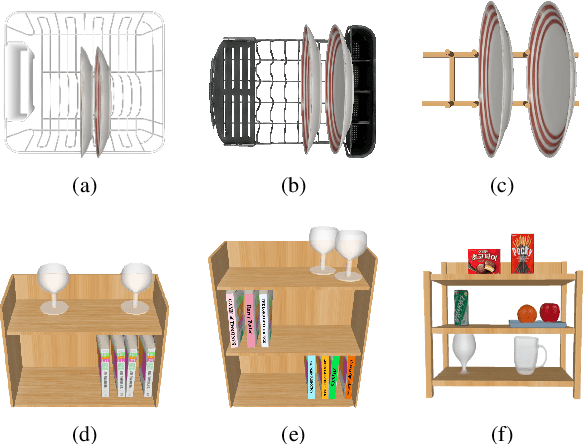
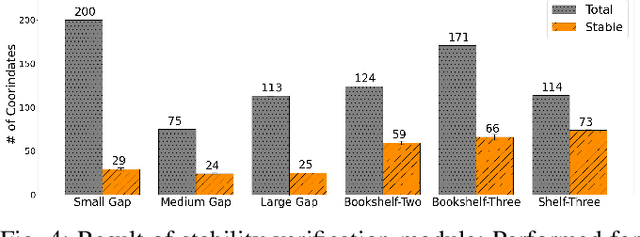
Abstract:Pick-and-place is one of the fundamental tasks in robotics research. However, the attention has been mostly focused on the ``pick'' task, leaving the ``place'' task relatively unexplored. In this paper, we address the problem of placing objects in the context of a teleoperation framework. Particularly, we focus on two aspects of the place task: stability robustness and contextual reasonableness of object placements. Our proposed method combines simulation-driven physical stability verification via real-to-sim and the semantic reasoning capability of large language models. In other words, given place context information (e.g., user preferences, object to place, and current scene information), our proposed method outputs a probability distribution over the possible placement candidates, considering the robustness and reasonableness of the place task. Our proposed method is extensively evaluated in two simulation and one real world environments and we show that our method can greatly increase the physical plausibility of the placement as well as contextual soundness while considering user preferences.
CLARA: Classifying and Disambiguating User Commands for Reliable Interactive Robotic Agents
Jun 22, 2023Abstract:In this paper, we focus on inferring whether the given user command is clear, ambiguous, or infeasible in the context of interactive robotic agents utilizing large language models (LLMs). To tackle this problem, we first present an uncertainty estimation method for LLMs to classify whether the command is certain (i.e., clear) or not (i.e., ambiguous or infeasible). Once the command is classified as uncertain, we further distinguish it between ambiguous or infeasible commands leveraging LLMs with situational aware context in a zero-shot manner. For ambiguous commands, we disambiguate the command by interacting with users via question generation with LLMs. We believe that proper recognition of the given commands could lead to a decrease in malfunction and undesired actions of the robot, enhancing the reliability of interactive robot agents. We present a dataset for robotic situational awareness, consisting pair of high-level commands, scene descriptions, and labels of command type (i.e., clear, ambiguous, or infeasible). We validate the proposed method on the collected dataset, pick-and-place tabletop simulation. Finally, we demonstrate the proposed approach in real-world human-robot interaction experiments, i.e., handover scenarios.
Towards Text-based Human Search and Approach with an Intelligent Robot Dog
Feb 10, 2023Abstract:In this paper, we propose a SOCratic model for Robots Approaching humans based on TExt System (SOCRATES) focusing on the human search and approach based on free-form textual description; the robot first searches for the target user, then the robot proceeds to approach in a human-friendly manner. In particular, textual descriptions are composed of appearance (e.g., wearing white shirts with black hair) and location clues (e.g., is a student who works with robots). We initially present a Human Search Socratic Model that connects large pre-trained models in the language domain to solve the downstream task, which is searching for the target person based on textual descriptions. Then, we propose a hybrid learning-based framework for generating target-cordial robotic motion to approach a person, consisting of a learning-from-demonstration module and a knowledge distillation module. We validate the proposed searching module via simulation using a virtual mobile robot as well as through real-world experiments involving participants and the Boston Dynamics Spot robot. Furthermore, we analyze the properties of the proposed approaching framework with human participants based on the Robotic Social Attributes Scale (RoSAS)
Active Visual Search in the Wild
Sep 20, 2022
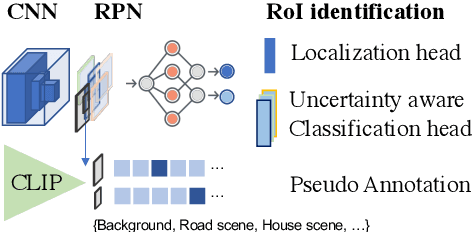
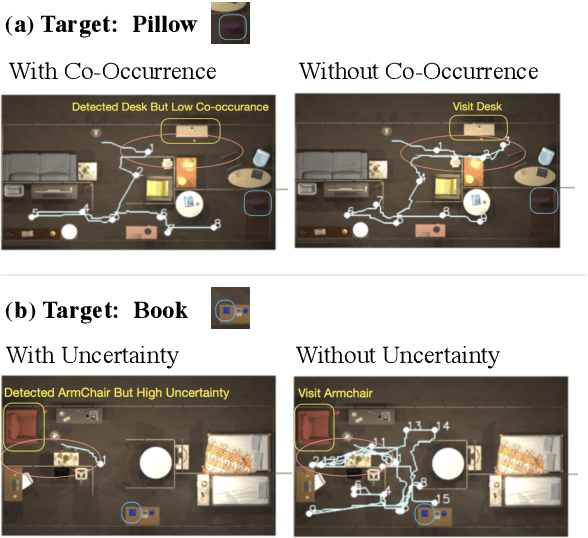
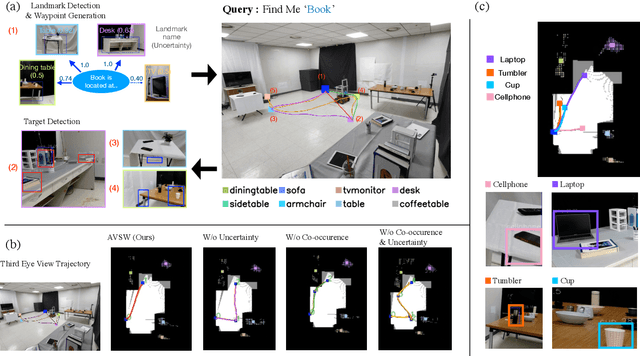
Abstract:In this paper, we focus on the problem of efficiently locating a target object described with free-form language using a mobile robot equipped with vision sensors (e.g., an RGBD camera). Conventional active visual search predefines a set of objects to search for, rendering these techniques restrictive in practice. To provide added flexibility in active visual searching, we propose a system where a user can enter target commands using free-form language; we call this system Active Visual Search in the Wild (AVSW). AVSW detects and plans to search for a target object inputted by a user through a semantic grid map represented by static landmarks (e.g., desk or bed). For efficient planning of object search patterns, AVSW considers commonsense knowledge-based co-occurrence and predictive uncertainty while deciding which landmarks to visit first. We validate the proposed method with respect to SR (success rate) and SPL (success weighted by path length) in both simulated and real-world environments. The proposed method outperforms previous methods in terms of SPL in simulated scenarios with an average gap of 0.283. We further demonstrate AVSW with a Pioneer-3AT robot in real-world studies.
Elucidating Noisy Data via Uncertainty-Aware Robust Learning
Nov 02, 2021

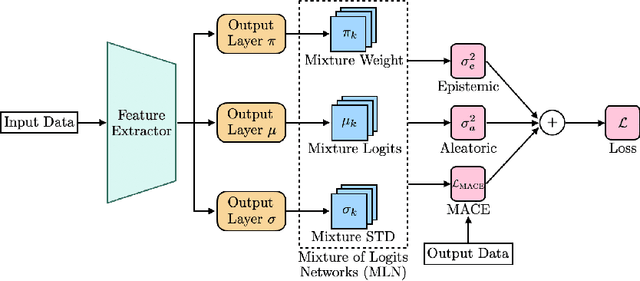
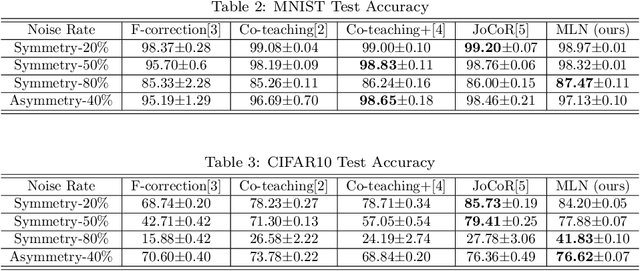
Abstract:Robust learning methods aim to learn a clean target distribution from noisy and corrupted training data where a specific corruption pattern is often assumed a priori. Our proposed method can not only successfully learn the clean target distribution from a dirty dataset but also can estimate the underlying noise pattern. To this end, we leverage a mixture-of-experts model that can distinguish two different types of predictive uncertainty, aleatoric and epistemic uncertainty. We show that the ability to estimate the uncertainty plays a significant role in elucidating the corruption patterns as these two objectives are tightly intertwined. We also present a novel validation scheme for evaluating the performance of the corruption pattern estimation. Our proposed method is extensively assessed in terms of both robustness and corruption pattern estimation through a number of domains, including computer vision and natural language processing.
Trajectory-based Reinforcement Learning of Non-prehensile Manipulation Skills for Semi-Autonomous Teleoperation
Sep 27, 2021



Abstract:In this paper, we present a semi-autonomous teleoperation framework for a pick-and-place task using an RGB-D sensor. In particular, we assume that the target object is located in a cluttered environment where both prehensile grasping and non-prehensile manipulation are combined for efficient teleoperation. A trajectory-based reinforcement learning is utilized for learning the non-prehensile manipulation to rearrange the objects for enabling direct grasping. From the depth image of the cluttered environment and the location of the goal object, the learned policy can provide multiple options of non-prehensile manipulation to the human operator. We carefully design a reward function for the rearranging task where the policy is trained in a simulational environment. Then, the trained policy is transferred to a real-world and evaluated in a number of real-world experiments with the varying number of objects where we show that the proposed method outperforms manual keyboard control in terms of the time duration for the grasping.
Towards Defensive Autonomous Driving: Collecting and Probing Driving Demonstrations of Mixed Qualities
Sep 18, 2021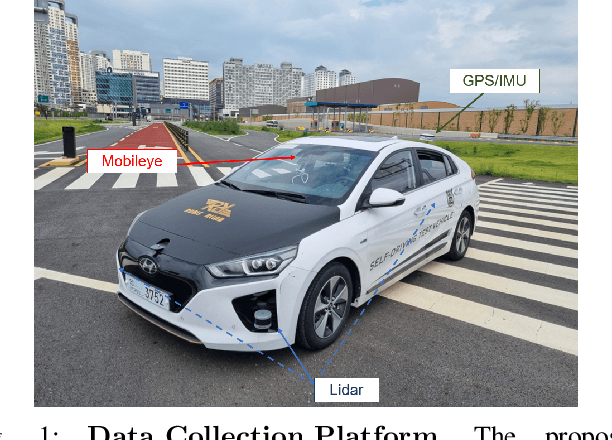

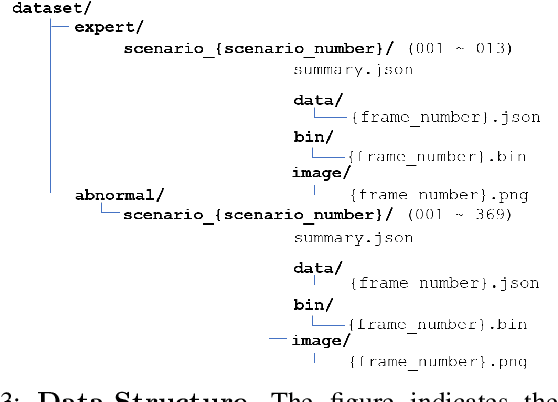
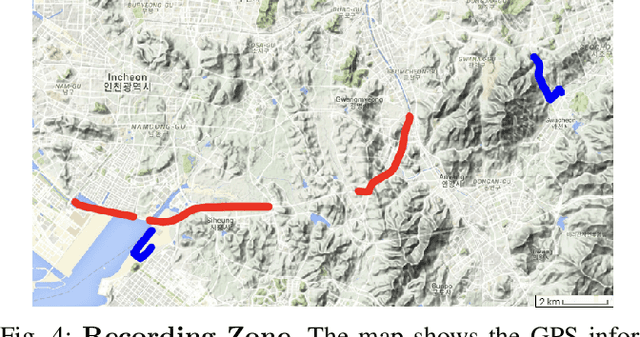
Abstract:Designing or learning an autonomous driving policy is undoubtedly a challenging task as the policy has to maintain its safety in all corner cases. In order to secure safety in autonomous driving, the ability to detect hazardous situations, which can be seen as an out-of-distribution (OOD) detection problem, becomes crucial. However, most conventional datasets only provide expert driving demonstrations, although some non-expert or uncommon driving behavior data are needed to implement a safety guaranteed autonomous driving platform. To this end, we present a novel dataset called the R3 Driving Dataset, composed of driving data with different qualities. The dataset categorizes abnormal driving behaviors into eight categories and 369 different detailed situations. The situations include dangerous lane changes and near-collision situations. To further enlighten how these abnormal driving behaviors can be detected, we utilize different uncertainty estimation and anomaly detection methods to the proposed dataset. From the results of the proposed experiment, it can be inferred that by using both uncertainty estimation and anomaly detection, most of the abnormal cases in the proposed dataset can be discriminated. The dataset of this paper can be downloaded from https://rllab-snu.github.io/projects/R3-Driving-Dataset/doc.html.
 Add to Chrome
Add to Chrome Add to Firefox
Add to Firefox Add to Edge
Add to Edge